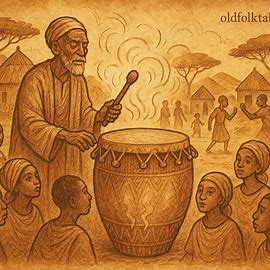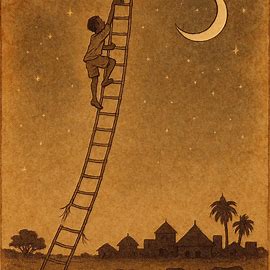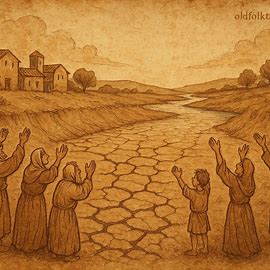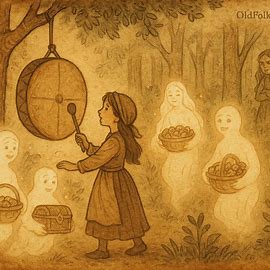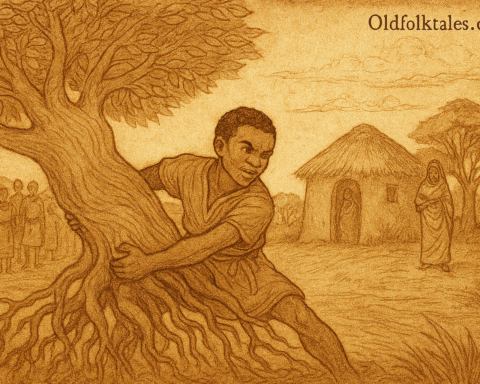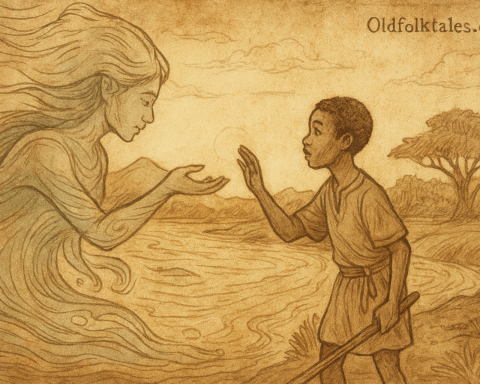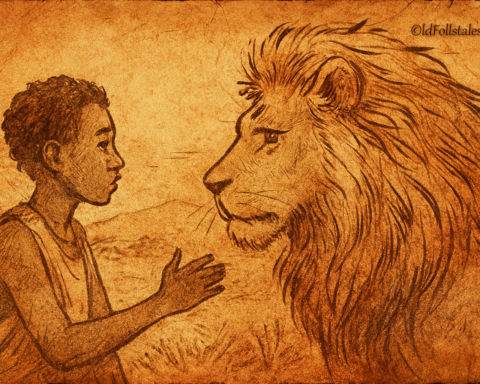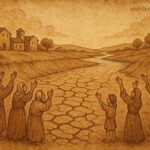Long ago, in a village nestled among wide plains and tall trees, quarrels broke out almost every day. Neighbors argued over grazing lands, brothers clashed about inheritance, and even friends shouted at each other over the smallest things. The air of the settlement seemed heavy with anger, and though seasons passed, no lasting peace could be found. Among the villagers lived an old man, quiet but known for his wisdom. He watched the constant disputes and feared that the spirit of discord would bring ruin upon them all.
One evening, the wise man went into the forest, seeking counsel from the silence of nature. After hours of wandering, he came upon a towering tree, broad and ancient, with roots that seemed to hold the earth itself together. From this tree, he carved a drum, shaping it with great care. The people thought it was an ordinary instrument, meant to call them together for meetings or dances. Yet when the man struck the drum, an extraordinary thing happened: the instrument spoke with the voice of a human.
“Live in peace,” it said in a firm, resounding tone, “or misfortune will strike you all.”
The villagers gasped in wonder. For a moment, their anger subsided, silenced by the power of the drum. They began to heed its warning. Old grudges were set aside, and quarrels that once threatened to split families were eased. When arguments arose, the elders struck the drum, and its voice reminded the people of the danger of discord. The village grew calmer, and for a while harmony returned.
But as weeks turned into months, the villagers began to grow careless. Peace felt too simple, and old habits crept back into their hearts. Soon disputes flared again, though quieter at first. A family bickered over harvest shares; hunters fought over who deserved the choicest game. Little by little, the memory of the drum’s warning faded like smoke on the wind.
One day, a heated quarrel erupted in the center of the village. Blows were exchanged, voices rose, and neighbors called each other enemies once more. In desperation, they struck the drum. Its deep sound echoed, but this time it did not speak. They struck again and again, harder and louder, yet no human voice came forth. The drum was silent.
That night, unease spread through the village. The silence of the drum felt heavy, almost like a curse. When dawn came, the people awoke to a strange sickness creeping among them. One by one, families were struck down with fever. Crops withered in the fields, and animals grew restless. Fear swept across the village, and only then did they remember the forgotten words: “Live in peace, or misfortune will strike you all.”
But it was too late. The drum had given its warning once, and it would not speak twice. The wise man, saddened but powerless, could only watch as his people suffered the consequences of their own carelessness.
Since then, the elders of that land have passed down the tale, warning the young with solemn voices: “The drum does not always speak twice.” For in their hearts they knew, the gift of peace, once ignored, might never return so easily.
Moral Lesson
This tale reminds us that peace is a treasure more fragile than people realize. When warnings come, whether through wise counsel, a sacred symbol, or the voice of a magical drum, they are not endless. Ignoring them brings consequences that may be impossible to reverse.
The story teaches that harmony within families and communities must be actively protected. Waiting for repeated warnings is folly, for life rarely gives second chances. To live in peace is not just advice, but a duty to ensure survival and well-being for all.
Knowledge Check
1. Who carved the drum in the story?
A wise man from the village carved it from a great tree.
2. What message did the drum first speak?
It said: “Live in peace, or misfortune will strike you all.”
3. How did the villagers initially respond to the drum’s warning?
They obeyed for a while, set aside quarrels, and lived more peacefully.
4. Why did the drum fall silent later?
The villagers ignored its warning, returned to fighting, and lost its gift of speech.
5. What happened after the drum stopped speaking?
Sickness spread through the village, and misfortune struck the people.
6. What lesson do elders repeat about the drum?
“The drum does not always speak twice,” meaning warnings should be heeded the first time.
Source: Sudanese folktale, collected among the Dinka people by Frobenius, 1923.
